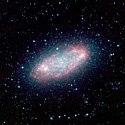NGC 2976
| Galaxie NGC 2976 | |
|---|---|
 | |
| SDSS-Aufnahme, Bildwinkel 9' × 9' | |
| AladinLite | |
| Sternbild | Großer Bär |
| Position Äquinoktium: J2000.0, Epoche: J2000.0 | |
| Rektaszension | 09h 47m 15,4s[1] |
| Deklination | +67° 54′ 59″[1] |
| Erscheinungsbild | |
| Morphologischer Typ | SAc pec[1] |
| Helligkeit (visuell) | 10,1 mag[2] |
| Helligkeit (B-Band) | 10,8 mag[2] |
| Winkelausdehnung | 5,9′ × 2,7′[2] |
| Positionswinkel | 143°[2] |
| Flächenhelligkeit | 13,0 mag/arcmin²[2] |
| Physikalische Daten | |
| Zugehörigkeit | M81-Gruppe, LGG 176[1][3] |
| Rotverschiebung | 0,000010 ± 0,000017[1] |
| Radialgeschwindigkeit | (+3 ± 5) km/s[1] |
| Hubbledistanz vrad / H0 | (5 ± 0) · 106 Lj (1,44 ± 0,12) Mpc [1] |
| Durchmesser | 20.000 Lj |
| Geschichte | |
| Entdeckung | William Herschel |
| Entdeckungsdatum | 8. November 1801 |
| Katalogbezeichnungen | |
| NGC 2976 • UGC 5221 • PGC 28120 • CGCG 312-023 • MCG +11-12-025 • IRAS 09431+6809 • KUG 0943+681 • 2MASX J09471545+6754589 • GC 1905 • H I 285 • h 625 • | |
NGC 2976 ist eine Spiralgalaxie, die etwa 11,4 Millionen Lichtjahre von der Milchstraße entfernt ist. NGC 2976 ist eine Begleitgalaxie von M81 und ist ein Mitglied des Galaxienhaufens M81-Gruppe.
Die Galaxie wurde am 8. November 1801 von dem deutsch-britischen Astronomen Friedrich Wilhelm Herschel entdeckt.[4]
Andere Bilder
Infrarotaufnahme von der Galaxie NGC 2976 vom Spitzer-Weltraumteleskop
UV-Aufnahme von NGC 2976 mittels GALEX
Hochaufgelöste Detailaufnahme des Hubble-Weltraumteleskops
Weblinks
Einzelnachweise
Auf dieser Seite verwendete Medien
Autor/Urheber: Sloan Digital Sky Survey, Lizenz: CC BY 4.0
The sky image is obtained by Sloan Digital Sky Survey, DR14 with SciServer.
Angle of view: 8' × 8' (0.3" per pixel), north is up.
Details on the image processing pipeline: https://www.sdss.org/dr14/imaging/jpg-images-on-skyserver/Astronomers were surprised to find that star-formation activities in the outer regions of NGC 2976 have been virtually asleep because they shut down millions of years ago. The celebration is confined to a few die-hard party-goers huddled in the galaxy’s inner region. The explanation, astronomers say, is that a raucous interaction with M81, a neighbouring group of hefty galaxies, ignited star birth in NGC 2976. Now the star-making fun is beginning to end. Images from NASA’s Hubble Space Telescope show that star formation in the galaxy began fizzling out in its outskirts about 500 million years ago as some of the gas was stripped away and the rest collapsed toward the centre. With no gas left to fuel the party, more and more regions of the galaxy are taking a much-needed nap. The star-making region is now confined to about 5,000 light-years around the core.
NGC 2976 The SINGS image is a four channel false color composite, where blue indicates emission at 3.6 microns, green corresponds to 4.5 microns, and red to 5.8 and 8.0 microns. The contribution from starlight (measured at 3.6 microns) in this picture has been subtracted from the 5.8 and 8 micron images to enhance the visibility of the dust features.
NGC 2976 by GALEX










